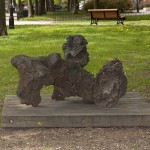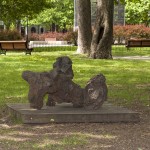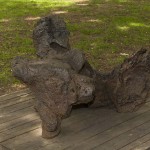

Born in Black Lake, this Québec artist was trained at the University of Ottawa and the École des beaux-arts de Montréal in the 1950s and is known for having upset well-established traditions in Québec, notably through his political engagement and his sculptural work.
Vaillancourt’s long and prolific career has featured by large-scale projects in the public space, including L’humain, a sculpture commissioned by the École des arts et métiers d’Asbestos (1963); Québec libre!, a fountain sculpture for San Francisco’s Embarcadero (1971); and Justice, an anti-apartheid artwork executed for the Palais de justice de Québec (1983).
- 19 Artworks
- 1h30min 30min
- Mont-Royal métro station
 Square Saint-Louis
Square Saint-Louis 
Artwork description
The presence of this artwork in Saint-Louis Square institutes a striking contrast among urban landscape, nature, and industry. On a base made of wood beams is placed a rough, irregularly shaped, ramified mass of iron.
In the middle of an urban park, the raw, abstract mineral volume bears the trace of a fabrication process emblematic of Vaillancourt’s artistic approach. Preferring industrial materials and techniques to traditional sculpture, the iconoclastic artist used a technique uncommon at the time, consisting of assembling carved and broken pieces of Styrofoam to create the cast for the piece.
The different textures produced by this method of casting iron invite viewers to have a tactile experience of the sculpture. Direct contact with the artwork – in contrast to limits prescribed in museums – was in fact the central theme of the event for which the work was installed in this site.




